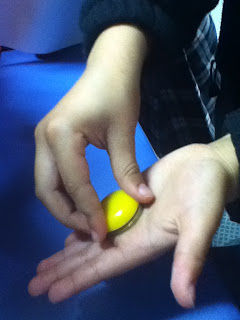In Room 4 our current focus for science is "Materials".
We are learning what the various properties of different materials are, and which materials are suitable for certain kinds of jobs e.g rubber for tires due to it's grip and durability etc.
Our latest set of investigations were about discovering what makes something magnetic, and how to identify magnetic materials.
First Mrs Nansen gathered some prior knowledge, to find out what we already knew.
"What does Magnetic mean?"
Charlize: "Magnetic things stick together."
Roman: "They go to each other."
We all had similar ideas.
We then teamed up in pairs with a class magnet to find out if a range of materials were magnetic or non magnetic.
We tested objects to see if we could feel any attraction (pulls) or resistance (pushes) to our magnets.

Tinashe and Caleb are testing the pencils to see if they are magnetic...
Keilani and Erika Lee have completed a test and are recording their results (sorry it's a bit tricky to read our test sheets!)
On our test sheets we indicated whether an item was magnetic or non-magnetic by using a smile-scale. So here is our own smile scale...
Erika Lee and Keilani are showing us that books are non magnetic
Alize and Mikayla are showing us that this ruler is non magnetic
Gideon and Roman are showing us that the .50 and .10c coin are magnetic (We were very interested to see that the $1.00 and $2.00 coins are non magnetic...ooooo!)
Jacob and Carlos found out that paper-clips are magnetic
Ekklesia and Brooklyn found out that connector blocks are non-magnetic
Shannahl and Liana discovered scissors are definitely magnetic!
Genesis and Caleb found out that rubbers are non magnetic
The next stage was to find out WHY all these objects are non/magentic. We discussed our findings, and our reasoning behind them.
"Those things {the magnetic objects} are magnetic because they have magnets in them" was the most common statement.
Then Mrs Nansen showed us some special 'dust'. We guessed what the dust could be...lead shavings from a pencil...black sand...magnet powder ;)
Then Mrs Nansen got out a magnet and placed it under the paper with the dust on it
The magnet made the dust move around the paper! It followed the magnetic through the paper. It reminded us of our "Magna Doodles"!
When Mrs Nansen waved the magnet over the dust, all the dust leapt of the paper and stuck to the magnet like "fuzz" (says Jacob).
We experimented passing the dust from magnet to magnet. When we wiped the 'fuzz' off the magnet, it fell back to the paper like dust again!
Mrs Nansen explained that the 'dust' was Iron Filings. Small particles of iron. We learnt that iron is a naturally-occurring metal that comes from within the earth. The iron has properties within it that make it magnetic. Many of the items we tested that were magnetic were made with some iron, or a similar naturally-occurring metal from within the earth. This is why they were magnetic!!
In our next lesson we are going to learn about atoms, electrons and charges!
ROOM FOUR LOVE SCIENCE!!


















No comments:
Post a Comment